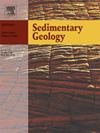Clay mineral authigenesis as an example of organomineralization in Paleozoic coated grains and peloids
IF 2.9
2区 地球科学
Q1 GEOLOGY
引用次数: 0
Abstract
The formation of clay minerals in marine environments, referred to as reversed weathering, represents an important process significantly affecting seawater chemistry. In this study, we describe organomineralization represented by clay mineral authigenesis associated with remnants of carbonaceous microstructures, interpreted as extracellular polymeric substances (EPS), from Silurian, Devonian, and Carboniferous coated grains (ooids, oncoids, and cortoids) and peloids (micritized grains). Multiple lines of evidence support the authigenic origin of these clay minerals: (1) Systematic spatial relationships with organic templates demonstrated through BSE imaging and elemental mapping; (2) Consistent qualitative elemental compositions across samples of varying ages, depositional settings, and burial histories; (3) Systematic textural, morphological, and compositional differences from detrital clay minerals, including filamentous texture, diffuse irregular boundaries, and higher Mg/(Al + Mg) and Si/(Si + Al) ratios; (4) XRD identification of authigenic I/S R3 with a diagnostic 1Md polytype structure; and (5) Consistency with the well-documented association of authigenic clay minerals with microbial surfaces, as evidenced by numerous laboratory experiments.
The documentation of authigenic clays associated with microbial structures in these common constituents of carbonate rocks suggests a potentially significant impact on element sequestration at the sediment-water interface and in the pore-water environment. We conclude that when properly contextualized, authigenic clay minerals can serve as indicators of former microbial surfaces.
古生代包覆颗粒和似质体中黏土矿物的自生作用
海洋环境中粘土矿物的形成被称为逆风化,是影响海水化学的一个重要过程。在本研究中,我们描述了以黏土矿物自生作用为代表的有机矿化作用,与碳质微观结构残留物相关,解释为细胞外聚合物(EPS),来自志留纪、泥盆纪和石炭纪的包被颗粒(卵状、卵状和皮质状)和粒状(微晶化颗粒)。多种证据支持这些粘土矿物的自生起源:(1)通过BSE成像和元素映射显示了与有机模板的系统空间关系;(2)不同年龄、沉积背景和埋藏史样品的定性元素组成一致;(3)碎屑黏土矿物在结构、形态和成分上存在系统性差异,包括丝状结构、弥散不规则边界和较高的Mg/(Al + Mg)和Si/(Si + Al)比值;(4)具有诊断型1Md多型结构的自生I/S R3的XRD鉴定;(5)与大量实验室实验证明的自生粘土矿物与微生物表面的良好关联一致。在这些碳酸盐岩的共同成分中,与微生物结构相关的自生粘土的记录表明,它们对沉积物-水界面和孔隙-水环境中的元素封存具有潜在的重大影响。我们的结论是,当适当的背景下,自生粘土矿物可以作为前微生物表面的指标。
本文章由计算机程序翻译,如有差异,请以英文原文为准。
求助全文
约1分钟内获得全文
求助全文
来源期刊

Sedimentary Geology
地学-地质学
CiteScore
5.10
自引率
7.10%
发文量
133
审稿时长
32 days
期刊介绍:
Sedimentary Geology is a journal that rapidly publishes high quality, original research and review papers that cover all aspects of sediments and sedimentary rocks at all spatial and temporal scales. Submitted papers must make a significant contribution to the field of study and must place the research in a broad context, so that it is of interest to the diverse, international readership of the journal. Papers that are largely descriptive in nature, of limited scope or local geographical significance, or based on limited data will not be considered for publication.
 求助内容:
求助内容: 应助结果提醒方式:
应助结果提醒方式:


